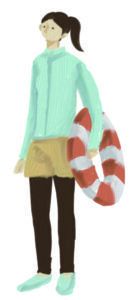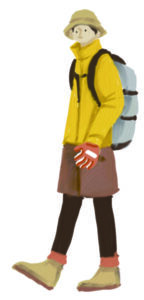2024.04.01
NewsCode of Conduct and Dangerous Plants and Animals Information
Before you embark on your adventure: Cherish the rare environment and be cautious of dangerous plants and animals.
The Oki Islands, part of Daisen-Oki National Park, are recognized as a UNESCO Global Geopark for their internationally valuable geological heritage and unique ecosystem. When enjoying outdoor activities such as hiking or marine sports, please respect the environment around you, be mindful of the local wildlife, and ensure your safety at all times.
This land that took shape over many years and the living beings that took root here, including the plants and insects that make up the unique ecosystem of living, breathing Oki, are the irreplaceable treasures of the Oki Islands. Help us ensure that our human hands do not destroy the nature that formed here over several tens of thousands of years by refraining from mining, digging, or logging without permission.
Protect the nature
Please help us conserve and protect the precious nature and geological heritage of the Oki Islands!
- Cherish the environment and minimise your ecological impact when visiting the Oki Islands.
Do not collect or disturb the animals, plants and rocks. - Take your litter away with you.
Prepare a garbage bag and bring it with you before heading out. - Do not wander off the hiking tracks and designated routes.
Such actions may destroy the habitats of animals and plants. - Please put your dog on a leash.
It is prohibited by law to let your pets loose in Special Protection Zones and some of the Special Zones of the Daisen-Oki National Park. The following areas are special protection zones on the Oki Islands:
Kuniga Coast (Nishinoshima Island), the area near Sekiheki Red Cliff (Chibu Village), Mt. Daimanji, Shirashima Coast, Jōdogaura Coast and Dangyō-no-taki Waterfalls (Okinoshima Town). - Camping and the use of fire outside designated areas are strictly prohibited. Please note that campgrounds have different opening dates.
- Fishery rights are established in the waters of the Oki Islands.
Do not collect abalone, sazae turban shells, sea urchins, etc. If you violate rules, you may be punished for breaking the law. Please also refrain from swimming in a wetsuit, as you could be mistaken for a poacher. - Swimming outside beaches or designated areas is not recommended.
There are no surveillance staff at the beaches outside the swimming season or at the beaches in Chibu Village even during the swimming season. - Fishing is allowed in most areas on the islands.
However, please avoid fishing at ports and zones where vessels enter or exit. Also, please dispose of the related garbage responsibly.

Be respectful of the local culture
Numerous festivals of the Oki Islands have been passed down from ancient times, and they reflect the unique culture of the islands. A lot of the festivals have a religious background, therefore visitors should be careful when participating.
Another characteristic of the festivals is that compared to urban areas, there are fewer visitors and participants are mostly residents. A good rule of thumb is to observe the local people around you and read the atmosphere.
Please keep in mind the following:
- It could become dangerous to stay too close to the parade or other participants. Please be careful of the situation around you.
- Please refrain from cheering or making noises that interfere with the procession or rituals.
- Do not cross the procession or parade troupe.
- Do not touch the mikoshi (portable shrine), the carriers of the mikoshi and the animals participating in the rituals.
- Do not stand behind the sacred horses, as you may get injured.
- Please refrain from using excessive flash when taking pictures.

Mikoshi (Portable Shrine) Procession, Yurahime Shrine Festival in Nishinoshima Town; Shinto rituals before Mina-ichi Dance in Chibu Village, Uma-ire-shinji ritual, Tamawakasu-mikoto Shrine in Okinoshima Town
Prepare before your outdoor adventure!
While there is no need for heavy equipment when hiking in the Oki Islands, please wear adequate clothing and bring some food and drink.
Hiking and Walking
Hat: Wear a light-coloured hat. It is good to avoid dark colours as wasps and hornets are sensitive to them.
Long-sleeved shirt: Cover your skin to protect yourself from potential abrasions or dangerous plants and insects. Wasps and hornets are sensitive to dark colours so choose light-coloured clothing.
Long trousers: Cover your skin to protect yourself from potential abrasions or dangerous plants and insects.
Backpack: Some trails are steep. Put your supplies in a backpack to have both hands free when hiking.
Hiking gloves: Necessary when hiking Mt. Daimanji and Washigamine Ridge trails.
Hiking shoes and long socks: There are some steep trails in the Oki Islands so we recommend wearing light hiking shoes. Put on some long socks too, to protect yourself from insects or dangerous plants.
To learn more about hiking and walking trails on the Oki Islands please refer to our Pocket Guide to Outdoor Activities in the Oki Islands.
Are you interested in joining a hiking or walking tour? Check out the available tours here.
Water Sports
Swimming season: The best season for marine sports is from mid-July through August.
Rash guard: Cover your skin to protect yourself from potential scrapes, sunburn and dangerous sea animals or plants.
Water shoes: Protect your feet from the rocky sea bottom or potential threats such as marine litter or sharp shells.

Attention!
Make sure to check the weather forecast before setting out on your excursion. Do not hike or do water sports when a thunderstorm advisory is in effect. Please inquire about the latest information on the hiking trails and sea bathing conditions at the local tourism offices. For detailed information about weather conditions on the Oki Islands throughout the year, see this page.
Watch out for these dangerous plants and animals!
About plants
Please do not forage and consume plants or creatures using your own judgement. It is extremely dangerous because some fruits, mushrooms, plants, and sea creatures are poisonous.
Lacquer trees, including poison ivy, are commonly seen around hiking trails; they can irritate, and even cause a severe allergic reaction to those especially sensitive to “urushiol”, an oily mixture in the plant’s sap.
Stinging nettle is another plant to watch out for, and one of the reasons we advise our visitors to wear long trousers when hiking.
Be also careful when admiring or touching pretty flowers, as some of them, for example, sweet autumn clematis or greater celandine may cause irritation or even blisters.
About land animals
Not a surprise for those who usually roam about outside, you can also stumble upon snakes and wasps during your adventures on the Oki Islands (and anywhere in Japan, really). While meeting with the fairly common, non-venomous Japanese rat snake might be surprising, it is not dangerous. However, two species of venomous snakes inhabit the islands. You must be observant of your surroundings and watch where you step.
Tiger keelback rarely strikes if not attacked, but it will bite if it senses danger. The Japanese pit viper is timid and will not attack unless approached, but might jump and bite if you get too close to it. This species can also climb trees up to around one metre, so please keep an eye out for them when hiking.
There are two types of wasps you should be especially careful about—hornets and paper wasps. Hornets tend to build their nests in the ground; so be careful when you are on the trail and keep to the track. Both hornets and paper wasps are most aggressive in late summer and autumn, defending their new nests and queens. Avoid wearing dark-coloured clothes and perfume, as these provoke insects. When you see a wasp flying towards you, stay still and calm; do not swat at it.
About marine animals
Marine activities are very popular on the Oki Islands, and it is important to know which sea creatures are dangerous and should be avoided when spotted. The jellyfish that is most likely to be seen is the common jellyfish, which is generally not dangerous to humans.
However, other types of jellyfish—such as box jellyfish and Nomura’s jellyfish—are also known to have been spotted around the Oki Islands which can cause harm to humans. It is best not to touch any jellyfish at all, even when they are washed on shore; the cells in the tentacles can still sting you.
Other than jellyfish, black longspine urchins, cone snails and goblinfish among others are reasons why we recommend wearing protective footwear while swimming.
For detailed information and tips on what to do in case you get stung or bitten, and what to do in case of an accident during your outdoor adventures, see this brochure.
Remember: it is always best to get professional help. Depending on the situation, please make sure to visit the local hospital or a clinic. The emergency services numbers are:
Fire, ambulance and emergency rescue: 119
Police: 110
Japan National Tourism Organization operates a Japan Visitor Hotline, so we recommend researching beforehand and saving their number.


